Student Trip to Tillamook Forest Center
Hosted by Carrie Cantrell, Produced by The Let's Talk! Podcast Collective
Student Trip to Tillamook Forest Center
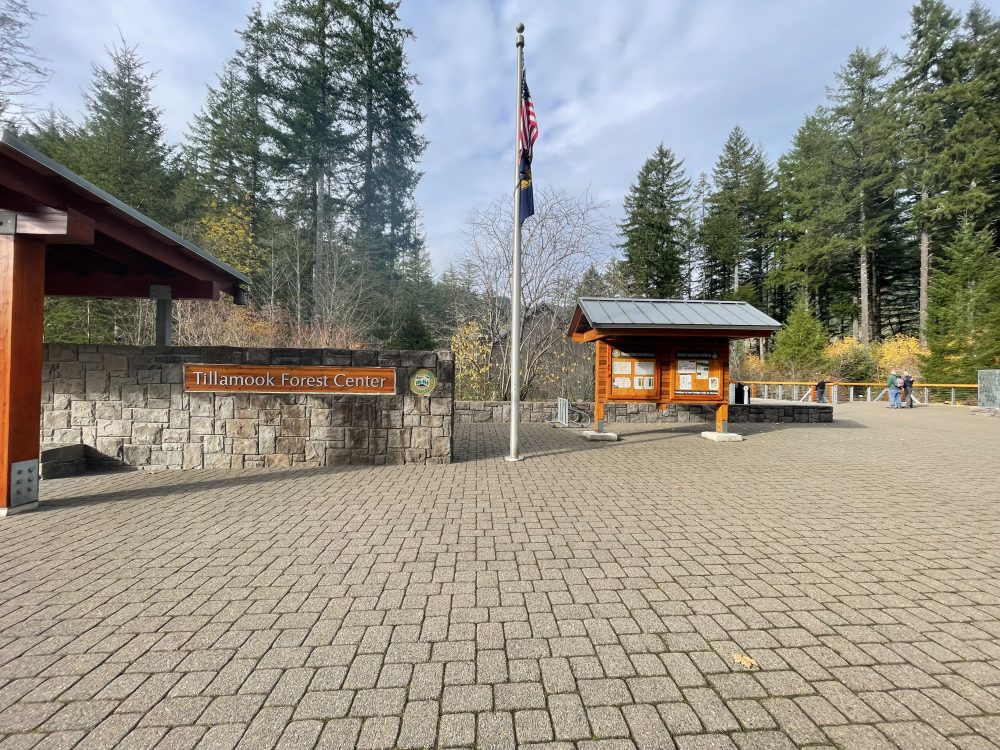
Photo credit: Carrie Cantrell. The Tillamook Forest Center welcome area.
On November 18, PCC students and faculty gathered in PCC’s campus parking lot 5 off of Mississippi Avenue in North East Portland. The weather was bright and cool, and the morning air promised adventure for the day.
Led by Student Life and Leadership of ASPCC and the Oregon Department of Forestry at Tillamook State Forest, the gathering was registered to undertake the 45-mile journey to Tillamook State Forest to participate in the seasonal salmon fry release into Jones Creek.
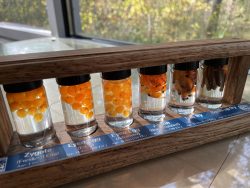
Photo credit: Carrie Cantrell. Specimen vials showing salmon egg development.
A working forest, Tillamook State Forest is a publicly owned and managed resource encompassing Washington, Tillamook, Yamhill, and Clatsop counties. Every year, contracted loggers cut thousands of trees, and the revenue from this harvest contributes to Oregon’s schools and other public services. To maintain the population of salmon, a keystone species in watershed ecology, the Oregon Department of Forestry and the Oregon Department of Fish and Wildlife supplement the streams with releases of salmon hatchlings twice a year. The forestry center hosts outreach and involvement events open to the public to educate and engage them in shared resources.
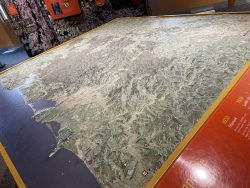
Photo credit: Carrie Cantrell. Topographic map of the Tillamook State Forest.
It is one such event that the PCC students are attending today. After about an hour’s drive outside of the city into Tillamook State Forest, they are greeted by a Welcome Center Employee named Alejandro Arellano, who explains the safety protocols for exploring the area and gives a brief overview of the forest’s history and importance—economically and ecologically—to Oregonians across the state.
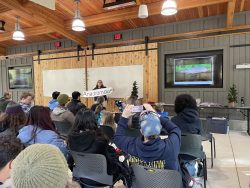
Photo credit: Carrie Cantrell. Denise Berkshire teaching about the salmon life cycle.
The PCC cohort has a chance to explore the grounds and exhibits on their own before gathering in Tillamook Forest Center’s main Community Hall, where the Forest Center Director (Denise Berkshire) guides them as well as a group of other forest visitors on an in-depth lesson on the life cycle of salmon, their significance throughout history, and their essential place in the forest eco-system. Denise passes around preserved salmon eggs and fry specimens in various life stages. She utilizes volunteers to demonstrate the salmon life cycle from hatching, migrating to the ocean, and finally returning to their hatching grounds to spawn. The talk is accessible to all ages and abilities, as it incorporates both visual, auditory, and demonstrative teaching methods and shies away from scientific jargon (except Denise’s Word of The Day–Anadromous, meaning a species of fish that migrates between salt and fresh water).
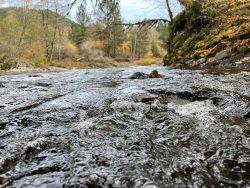
Photo credit: Carrie Cantrell. Close up of Jones Creek.
After the presentation, the entire room of students, youth, middle-aged and elderly Oregonians trek down a short and easy hike to the banks of Jones Creek, where Forest Center employees pass out small plastic cups, each containing two or three salmon fry, to be released into the nearby trickling water system to supplement the wild stock of fish.
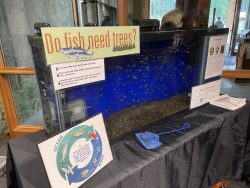
Photo credit: Carrie Cantrell. Tank of salmon fry inside the Forest Center.
The reactions and expressions of nature-goers were of excitement, joy, and pride as they helped their fishy friends find their way to their new homes. The fish eagerly took to the stream water after having been hatched inside a cozy 50-gallon tank inside the forest center months previously. Families, couples, and singles of all ages could participate in this opportunity to learn about and participate in nature’s cycles.
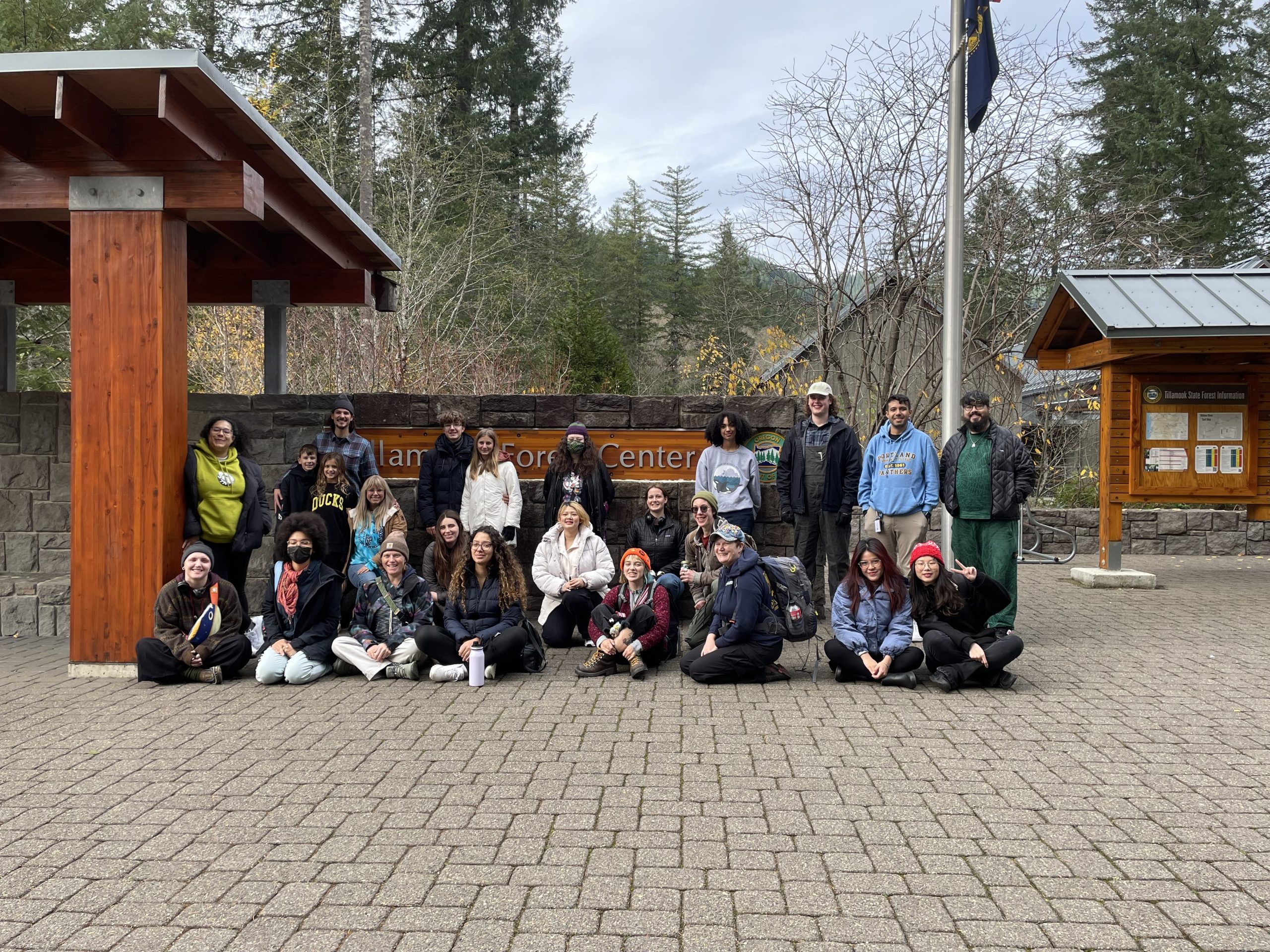
Photo credit: Carrie Cantrell. Group of PCC students, staff, friends, and family at the Tillamook Forest Center.
Let’s Talk!
“Student Trip to the Tillamook Forest Center”
Host and interviewer Carrie Cantrell travels with PCC’s Student Life and Leadership group to the Tillamook Forest Center to learn about salmon, sustainability, and equitable access to natural spaces.
Hosted By: Carrie Cantrell
Produced By: The Let’s Talk! Podcast Collective
Released on: 01/05/2024
Transcript
Transcript edited by Carrie Cantrell
Introduction
Carrie Cantrell: Thank you for listening to Let’s Talk. Let’s Talk is a digital space for students at PCC experiencing disabilities to share their perspectives, ideas, and worldviews in an inclusive and accessible environment. The views and opinions expressed in this program are those of the speakers and do not necessarily reflect the views or positions of Portland Community College, PCC Foundation, or X Ray FM. We broadcast biweekly on our home website, pcc.edu/dca, on Spotify, and XRay.FM, 91. 1 FM, 107. 1 FM, and online.
In the Tillamook State Forest, salmon live in the cool, clear waters that run through the coast range. On November 18th, we joined a group of PCC students as they traveled to Tillamook State Forest to explore the life cycles, habitat requirements, and underwater ecosystem that supports one of Oregon’s top industries.
The Tillamook State Forest is a 364, 000 acre publicly owned forest in the U. S. state of Oregon. Managed by the Oregon Department of Forestry. It is located 40 miles west of Portland in the northern Oregon coast range and spans Washington, Tillamook, Yamhill, and Clatsop counties. Listen now to the Tillamook Forest Center Director, Denise Berkshire, as she explains some history of the Tillamook State Forest and the salmon’s important role in Oregonian history.
Salmon Lifecycle Presentation
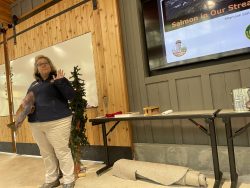
Photo credit: Carrie Cantrell. Denise Berkshire, the Forest Center Director.
Denise Berkshire: My name is Denise Berkshire, and I am the director of the Tillamook Forest Center. It is my lucky day because I’m not sitting at my desk, and I’m here with you, and I get to actually have a little bit of fun doing a fish release. We are often confused with the United States Forest Service. Before I started working for ODF, I didn’t know we had a state agency.
And you’re going to notice there’s something in both of those logos. What do you notice? The trees, right? So we take care of forests. The Oregon Department of Forestry takes care of state forests right here in Oregon. Before I started working for ODEF, I didn’t know we had state forests—the U. S. Forest Service takes care of national forests all across the United States. So, you are in the largest state forest, the Tillamook State Forest. You often might hear folks say Tillamook National Forest. We are State Forest and we manage these State Forests right here. Does anybody know what happened out here a long time ago?
We had a series of forest fires. So Oregonians decided they wanted to do something to help bring the forest back. They planted trees. We had Boy Scouts, Girl Scouts, Volunteers, Foresters, Adults in Custody, all sorts of people came out, collected cones, planted 72 million tree seedlings. No one had ever planted an entire forest before.
And from all their hard work, we have what we like to call the Sea of Green. And so this is the forest that we’re managing. This is the Tillamook State Forest. Once those trees got to a place where they were large enough, we do cut some trees. And we manage this forest for a balance of values. We manage it for social value, for y’all to come out and have fun like you are today.
Education programs, recreating, riding your motorcycles, go hiking. We also manage this forest for environmental value. We want to make sure that we have fish habitat, that we have all sorts of clean water and making sure that our environment is there. And then we also manage this forest for economic value.
Two thirds of the revenue that comes from this state, the forest here, from timber harvest, goes to the counties to support schools and other public services. Salmon have symbolized and continue to symbolize the Pacific Northwest. For tribes like the Tillamook, salmon have symbolized nature’s bounty.
And they have been fishing from time immemorial out here. And they have a lot of lessons associated with salmon. So today, salmon symbolizing all sorts of things for us. Our heritage. Jobs. Recreation. Fun. Right? That’s that recreation piece. And so what about the future? Well that all depends on making sure that we have enough salmon habitat.
Salmon have symbolized the Pacific Northwest for quite a while and continue to do so. You can remember the salmon life cycle by thinking about taking a trip to the beach. So salmon begin and end their lives in the forest. It doesn’t matter where you’re at in Oregon. If you’re driving from the valley to the coast, what are you going to drive through?
The forest. Well, the salmon and a lot of our highways are following those creeks to get down to the ocean. And they’re getting ready for that big journey. And they’re going to go from fresh water in the river to salt water in the ocean. And there’s a really big word for that. Anadromous. Can you all say that with me?
Anadromous. This is just a big scientific word that means migrating from freshwater to saltwater. They go down to the estuary where the freshwater and the saltwater are mixing and they’re going to hang out down there for a little bit. And when they’re down there, they change. They become smolt. They start to get scales, their tails fork, and this is going to provide them camouflage when they’re in the ocean.
When they actually go out into the full open ocean. Now, how long they spend out in the ocean depends on what kind of salmon they are. They spend their adult lives out in the ocean, and then you’ve been at the beach. What do you do a lot when you’re at the beach, when you’re at the ocean? So you eat a lot when you’re out at the beach or on vacation.
And that’s what the salmon are doing as adults. They’re growing, they’re eating a lot. They’re becoming adults, you know, and we’ve had a vacation. We’re at the beach, we’re getting ready to go back home. And the salmon, excuse me, are triggered that they need to go back to their home where they were born, where they hatched as eggs.
The salmon are gonna go the same stream. That they came down, and they’re going to use that by smelling the chemicals in the river, or their stream. That’s how they know which stream to get back to. So they spawn. They die. Which might seem sad, however, that is their life cycle. They begin and end their lives in the forest in the same place they were born.
When they die, they start decomposing in the river. And along the stream banks. And I mentioned to you early on that the forest can actually be ocean, forest, and people. Well, the salmon are bringing the nutrients from the ocean into the forest. So when they start decomposing, they are providing food for bears, fox, 22 different birds.
And believe it or not, they’re actually feeding the trees. Research recently shows that the salmon decompose into the soil, and scientists have found salmon in the trees. We work with the Oregon Department of Fish and Wildlife, and we put trees in the streams. We make sure that there’s hiding places for the salmon, because it’s a hard journey, and there’s a lot of predators out there.
We also have to say that we’re taking the right road. So after the fires, there were a bunch of legacy roads out here where they just kind of built over a road, put some dirt on it. We have been going back and putting these giant culverts in so the fish have a passage back to their native streams. We also have what’s called the riparian area.
Has anybody ever heard that word, riparian area? It’s just the green ribbons of land that is bordering—and especially fish bearing streams. And in Oregon here, we have what’s called the Oregon Forest Practices Act that says that every landowner that owns forest land has to follow a set of rules for riparian areas.
So here in state forest land, we make sure that we have trees to keep the water cool, clear and minimize erosion. Remember when she was looking, she was looking for the three C’s. Clean, clear, and cool water. Trees help with that. So we ask folks, if you see a place that’s got a sign that says please stay out, we’re trying to add vegetation.
We also ask that you stay on the trails and the bridges. Because if we cut trails, we can create erosion and sediment in the soil is good for fish. And then we also ask that when you’re out having fun So, you’re not building campfires right next to the screen, or in the screen. And they are only burning wood and paper.
And that’s because whatever is up in the air comes back down, and that can actually impact the salmon habitat in the stream. It kinda takes all of us to make sure of that future perspective for our salmon. So, salmon connect the ocean, forest, and people. They have and continue to symbolize the Pacific Northwest.
You can remember their life cycle by thinking about a trip to the beach and the Oregon Department of Forestry’s planting trees for the fish.
Interview with Alejandra Arellano
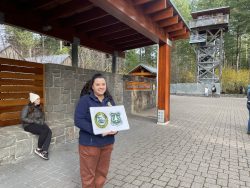
Photo credit: Carrie Cantrell. Tillamook Forest employee Alejandra Arellano.
Carrie Cantrell: We caught up with Alejandra Arellano, one of the Forest Center’s employees inside the visitor center where the salmon fry lived in a 50-gallon tank before their release into Jones Creek.
Are these the fry that are going to get released?
Alejandra Arellano: Yes.
Carrie Cantrell: Oh, how many are in this tank?
Alejandra Arellano: So we started off with about 500. Unfortunately we have had some casualties. So we have about 450 I would say in the tank right now that we’re going to release between today and tomorrow.
Carrie Cantrell: Okay, cool. Why do you release them in stages?
Alejandra Arellano: Just to have, get more people out here. Right now it’s our slow season just so people come and enjoy releasing the fish back into the creek. It’s not something that everybody gets to do. So in the spring we release steelhead and then in the fall we release the chinook salmon. Okay. We just give this information over to the Oregon Department of Fish and Wildlife. you know, how many survived, how many have hatched as they are going through the stage from egg to fry. Yeah. So we give that information over to the ODFW and then they collect that information from a whole bunch of different
Unknown Speaker (Tillamook Forest Employee): We’re just gonna move you guys over just so we can start collecting.
Carrie Cantrell: And they’re going to start collecting those. Have those fries been in the tank the entire time?
Alejandra Arellano: Yeah, so we got them, when was it? At the beginning of October, I believe. So we got them as eggs and then they hatched and now they’re ready to be released.
Carrie Cantrell: Where do you source salmon eggs from?
Alejandra Arellano: So we get them from them from ODFW, from the, I believe, the Trask Hatchery. So on the Trask River.
Carrie Cantrell: Okay, on the Trask hatchery.
Alejandra Arellano: Yes.
Carrie Cantrell: They’re being released into what body of water again?
Alejandra Arellano: Jones Creek, that feeds into the Wilson River.
Carrie Cantrell: Okay, very cool. Thank you so much.
Alejandra Arellano: Yeah, no problem.
Unknown Speaker (Tillamook Forest Employee): Unfortunately, because these things aren’t fin-clipped, there’s really no way to track them.
Carrie Cantrell: Okay. Fin clipping is one method of tracking them, though?
Unknown Speaker (Tillamook Forest Employee): They are running a brood stock program now for ODF& W that local guides are actually bringing live fish in and they’re putting them in live tanks. So ODF& W comes and counts those fish that aren’t fin clipped. So we do have somewhat of an idea of what does come down to Tillamook.
Interview with Cay Dillard
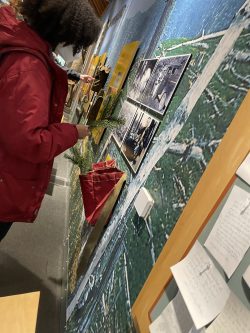
Photo credit: Carrie Cantrell. Cay Dillard, trip organizer and AAOT student at PCC.
Carrie Cantrell: Cay Dillard, a student at PCC, works for the Basic Needs, Sustainability, and Leadership Program at Portland Community College as an Eco Social Justice Ambassador. This program aims to address issues related to basic needs. including food and housing security, transportation access, legal aid, and the looming climate crisis.
This program offers resources such as emergency funds to students, food pantries, transportation solutions, and volunteer opportunities in order to advance an equitable and sustainable community for our students. You can find more information on this program by going to pcc.edu and searching for student leadership programs.
Cay Dillard: I’m Cay Dillard. I’m just getting an Associates of Science transfer degree so I can major in Marine Biology and Environmental Science when I transfer to a four-year year.
Carrie Cantrell: Oh, cool! Do you have any intentions on where you want to transfer to yet?
Cay Dillard: I’m thinking OSU, but I’m trying to keep some options open. I’m hoping to apply to some UCs and maybe to UW. I actually organized the trip. So I am an Eco Social Justice Ambassador with Basic Needs and Sustainability Leadership. And we run the Panther Pantries and stuff and we’re just trying to also increase opportunities for people to get involved with sustainability and learn more about the environment and how we affect it and how we can help.
You know, I think everyone just enjoys being out in nature. It’s such a, you know, calming and connecting kind of experience most of the time. So I feel like people really enjoy that aspect of things. No, I was a little bit worried about the hike, but I’m really glad that it’s just this small, short little hike that’s easy to access.
Carrie Cantrell: Yeah. Did you think about accessibility when you were planning this trip?
Cay Dillard: I did. I knew there were going to be some barriers and physical accessibility just because of the location.
Carrie Cantrell: Yeah.
Cay Dillard: I was bummed about that. But I did work to try to make everything, like, as accessible as I can.
Especially, I know there are a lot of financial barriers in a lot of these experiences.
Carrie Cantrell: Right.
Cay Dillard: And also just a lot of accommodation barriers, you know, like fatigue and stuff like that, so. It’s a really big deal to me for that stuff to be thought about.
Carrie Cantrell: That’s so wonderful. And it’s great to know there are other departments out there involved in that effort, making things accessible, especially events like this.
Cay Dillard: Yeah.
Interview with Haley Swain
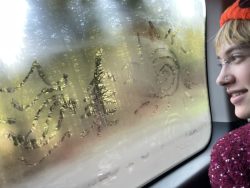
Photo credit: Carrie Cantrell. PCC student Haley Swain.
Carrie Cantrell: We spoke with a handful of students who were present for the Salmon release and asked them about their experiences.
[to Haley] Haley, how’s your day going so far?
Haley Swain: Great. I just got my little Alvins. Yeah, little Alvins that I’m gonna release. There’s three of them. There’s Cooper, Freddie, and Booger.
My name is Haley Swain, and my major is Environmental Landscape Management Technology. I learned that when the salmon die, they’re called spawn. They’re spawned, which is cool, because it makes me think of, like, them kind of coming back, like, almost like a rebirth.
Carrie Cantrell: Right, right, right, right. Yeah, it’s like a whole process, like life and death put together.
Haley Swain: And they do, like, rebirth four trees and four animals, and like, provide life, even when they’re gone. Like, that’s just so fascinating to me.
Interview with Cassidy Campbell
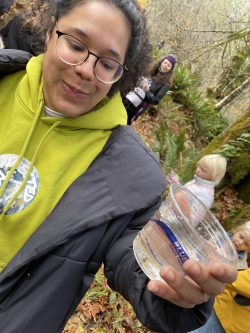
Photo credit: Carrie Cantrell. PCC student Cassidy Campbell.
Cassidy Campbell: My name is Cassidy Campbell and my major is communications. I was invited to drive the van, but also I really wanted to see the salmons get released. But I thought they were going to be really big, but I also enjoy my cup of salmon.
Carrie Cantrell: You have two salmon in your cup. Do you have names for them yet?
Cassidy Campbell: One is called Finn, but I don’t know what the other one is called yet. Maybe Robert.
Carrie Cantrell: That’s a good name. What do they look like? Can you describe them?
Cassidy Campbell: One is jumping and it makes me panic a little bit. But, um, but I can’t even describe the color. They look really cool. I like when they look through the cup at you. But I’m anxious to release them into the wild.
Carrie Cantrell: Did you learn anything from the presentation?
Cassidy Campbell: Yes, I didn’t know that this existed at all. I didn’t know why how can I say, why the little salmons are being released. But I think what I learned most is I think what will stick with me is the, what is it, the yolk pouch. Yeah. It’s a little gross.
Carrie Cantrell: But I like it. They’re a little chubby. But they’re cute.
Interview with Reo Moore
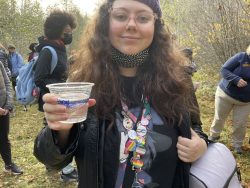
Photo credit: Carrie Cantrell. PCC multimedia student Reo Moore.
[to Reo] Do you mind if I ask you some questions for the Let’s Talk podcast?
Reanne Moore: Sure. My name is Reanne, or Reo. I’m in PCC and majoring in multimedia certificates.
Carrie Cantrell: What made you interested in coming out to the Tillamook State Forest today?
Reanne Moore: Just see what it’s like there. I’ve never been to Tillamook before. And I just want to see everything around Tillamook and want to see it and go from there.
Carrie Cantrell: What’s your impression so far?
Reanne Moore: Pretty fun.
Carrie Cantrell: Yeah? It’s beautiful out here.
Reanne Moore: It is.
Carrie Cantrell: Did you learn anything new in the presentation we just listened to?
Reanne Moore: Like the history of it. Like the fires before are really bad. And not good for the salmon.
Carrie Cantrell: That’s true, yeah. What do you want to do with your multimedia degree? Do you have any passions that you’re interested in pursuing?
Reanne Moore: I want to be a video editor.
Carrie Cantrell: Okay, excellent. Are you catching any cool video on your phone?
Reanne Moore: Yes.
Carrie Cantrell: Ooh, maybe you want to share some and we can put it on the website when we’re ready for the podcast.
Reanne Moore: Awesome.
Carrie Cantrell: Great.
Interview with Kwanjai Welch-Lucier
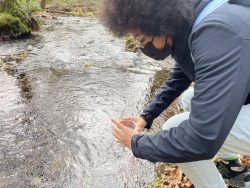
Photo credit: Carrie Cantrell. PCC student Kwanjai Welch-Lucier.
Kwanjai Welch-Lucier: I’m really excited about the release. I learned about the different life stages of salmon. I didn’t know about the alevin or the button-up stage. So that was really exciting. I’m really into salmon, so I already know quite a bit about them.
Carrie Cantrell: Really?
Kwanjai Welch-Lucier: Yeah. But I thought that it was a really great and clear presentation that explained the salmon life cycle very well. I’ve never seen salmon up close like this. You can see they have these little darker spots. A lighter coloration on their belly where you can still kind of see their yolk sac which makes me think they must be in their button up stage.
And the tips of their tails are a little orange. I’m a little afraid to name them since they’re probably gonna be gobbled up by something. And that would be a little sad.
Carrie Cantrell: Alright, we’re at the river. Where do you think is the best spot?
Kwanjai Welch-Lucier: Well, probably somewhere where I won’t have too much height over the water so that they won’t be too stressed.
Carrie Cantrell: Okay.
Kwanjai Welch-Lucier: So, maybe that bit of the bank right there would be good. With their coloration, they just disappear along the riverbed. I saw the guy for a couple seconds and then he was gone.
Interview with Denise Berkshire
Carrie Cantrell: We were able to speak with Denise Berkshire one one-on-one and asked her about her own personal opinions about diversity, equity, and inclusion, especially when it comes to accessibility at the Tillamook Forest Center.
Denise Berkshire: We were just talking this morning on the way over here about how this isn’t accessible because of our stairs, and I was thinking about folks, if they were coming, what we could offer and how we could accommodate them.
We had that conversation this morning when we walked over here, and so this is really incredible that they’ll at least be able to experience it digitally, and then we’re thinking ahead about how do we make, you know, things more accessible when we’re going down to the creek or, the kind of those other places.
Carrie Cantrell: So can you talk about what kind of accommodations you have on site now for visitors?
Denise Berkshire: I can. So for our fire lookout tower, we made sure that we had our exhibits at the base of the tower were similar that were at the top because it is a replica. So we don’t have an elevator to get up to the top. We do have a number of accessible items throughout the exhibit hall. Your standard building codes and things like that. But also, when we designed and built the facility, we wanted to make sure that it was very sensory. So, you know, if folks have particular limitations, like if you have a sight limitation, we have a lot of things that you can listen to.
If you have a hearing limitation, you have lots of things that you can see or touch or feel. And then we also are in process. Our recreation, education, and interpretation program has a strategic plan with diversity equity and inclusion incorporated into that, and so we’ll be working on planning and incorporating other components. So we’re kind of in the planning stages of enhancing that, but we have thought of things like our website and videos for the digital arena. But then also thinking about opportunities for sensory quiet spaces to be able to accommodate those that are on the autistic spectrum, or checking out, or having different kinds of needs that are met.
So there’s a whole gamut, as I’m sure you’re aware, to think about. And we are in the planning stages of that, and we are always thinking about that. From when we have a program and we set up our chairs, will a wheelchair be able to come through this aisle? And when we’re setting up our exhibits, are there any other accommodations that we need to be considering?
Carrie Cantrell: I’m already very impressed with the exhibits. I especially love the tactile map, the topo-map where the fires have been affecting, and this and this. That is such a crucial thing, especially for nonsighted people to be able to have a tactile experience. And like you said, there’s a lot of audio exhibits as well. Where do you get those types of media from?
Denise Berkshire: All of those exhibits were part of the initial design of the facility. That was all in the planning stages of the initial building. [to another person] Okay. Thank you. One more. [to Carrie] We, and so, as I mentioned, we wanted to make sure that things were very sensory. And so that, that is part of that. You know, we are working to do an exhibit refresh. Those exhibits were from 2006 and so as we’re moving into the future and we’re working with fundraising and looking at an exhibit refresh, that will be a pillar that we will be focusing on, in updating and modifying our exhibit tree for, the D.E.I. element that’s in there to making sure that we are, inclusive and accommodating to as many visitors as we possibly can be and thinking that through and then working with the communities to get their perspective and get their input as well.
Conclusion and Closing Statement
Carrie Cantrell: Thank you for listening to this episode of Let’s Talk. We learned that a lot of activities that we might take for granted, including the outdoors, simply aren’t accessible to everyone. Accessibility to natural spaces can have many benefits, including health, economy, society, exercise, and psychological.
Accessibility to green spaces is important for mental well-being, which has community implications for policymaking, urban planning, and health services. People with disabilities make up a large proportion of users of natural environments, and for this reason, we must make outdoor spaces in public lands more accessible and inclusive for everyone.
This short list from wilderness.org explains what steps we can take to make a jaunt to the woods more accessible for folks with disabilities.
- Remove physical barriers and build spaces that serve everyone. Uneven terrain, steep inclines, and a lack of ramps or handrails are just a few of the obstacles that people with disabilities often encounter in outdoor environments like national parks and trails.
- Let people know what’s waiting for them before they arrive. Providing accurate and comprehensive information about accessibility features, services, and programs available in outdoor spaces is vital. That means telling visitors what they will find before they arrive.
- Make sure people with disabilities are at the center of planning efforts. Enhancing accessibility in public lands requires collaboration among many stakeholders, government agencies, park officials, policymakers, disability advocacy organizations, and people with disabilities.
- Raise awareness and promote inclusion for everyone. It’s not just about developing ramps and better park maps. We also need to transform outdoor culture and combat more subtle forms of ableism. For instance, media about sports and outdoor recreation should reflect a fuller array of bodies and abilities.
- Tell the stories of the disability community. Public lands should depict a more holistic and truthful U. S. history by incorporating more stories from and about the disability community. Increasing national parks, monuments, and historic sites dedicated to preserving and interpreting these stories is crucial. These spaces should highlight the struggles, successes, and contributions of people with disabilities, not only honoring them, but also educating visitors about their challenges and progress.
So, by amplifying the voices of the disability community in these public spaces, we are working towards a more inclusive society that values empathy, understanding, and the importance of diversity.
